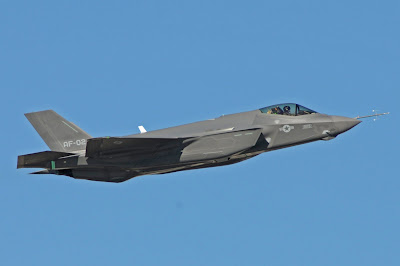
The latest cost projections from independent Pentagon analyists are placing the cost of the F-35 program, for the current number of airplanes projected, at $382 Billion.
This is 65% higher than the original cost projection of $232 Billion, posted in 2002.
The production cost per plane has risen to $92.4 Million, 85% higher than the original projection of $50 Million.
The total cost per plane, including R&D charges, is sitting at $112.4 Million, 81% higher than the original projection of $62 Million.
This is the incredible danger of our government signing 'cost plus' procurement contracts - contracts which guarantee the contractor(s) a percentage of profit no matter what the cost turns out to be. Such contracts give no incentive for the contractor to hold down costs - anything they can push into the program and bill for, they will.
I guarantee that if the US government had signed a fixed cost contract with Lockheed-Martin for the F-35, it would have come in at projected costs. Companies have a way of figuring out how to keep programs on track and on budget when their bottom line depends on it.
The new estimate of $382 follows by two months an estimate released by the F-35 program office in the Pentagon of $328 Billion.
The Congressional Budget Office released a report on May 28 suggesting that the Navy scale back on its planned purchase of F-35C carrier based variants, reducing its order by 93 aircraft. The resulting savings could be spent procurring an additonal 126 F-18 Super Hornets. The Super Hornet is a known design in service, orders could be placed and production started now. A difference of 33 aircraft may not sound like much, but that is the equivalent of 3 full strength Navy Fighter Squadrons. With the dire straits the Navy's legacy Hornet (F-18A/B/C/D) fleet finds itself in, additional Super Hornets could help bridge the Navy's fighter gap - a gap which has lengthened, since the Navy has pushed projected IOC for the F-35C from 2014 back to 2016.
A bad result from a cut in F-35C production is that it will drive the per plane cost up for everyone else, potentially causing even more production cuts.
The percentage of increase will automatically bring the program up for review by Congress, under the Nunn-McCurdy law. That stipulates that any project which exceeds its original budget numbers by more than 50% must be represented to Congress to justify the expense. Congress may take no action, but the law gives it the right to cancel the program outright.
The F-35 is rapidly becomming another F-22. It will be procured in far fewer numbers than were planned, due to the tremendous cost overruns. This will result in a much less combat effective force, and a fighter gap that we will not be able to overcome.
F-35 photo shamelessly ripped off from Outlaw13 ....

No comments:
Post a Comment